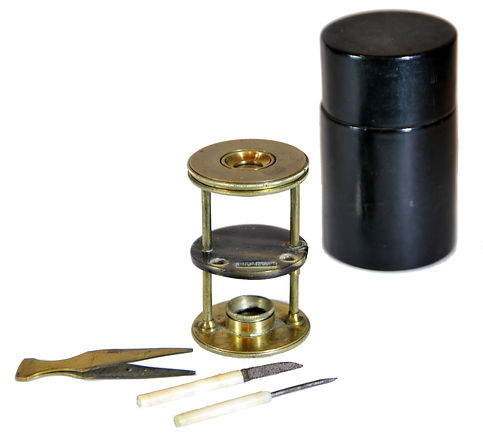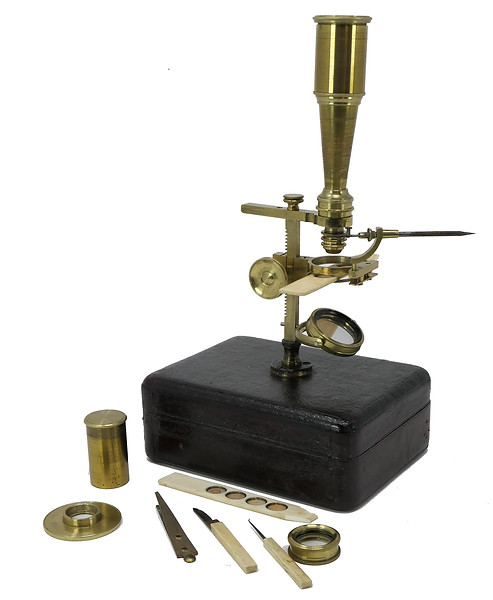

Withering-type botanical microscope, 1780
The “Withering-type Microscope” is named for its inventor, Dr. William Withering (1741-1799), an English physician and botanist who graduated with a degree in medicine 1766 in Edinburgh. Inspired by the taxonomical work and systematic classification of Carl Linnæus (1707-1778), Withering (1776) applied the Linnaean taxonomical system of classification to British plants in a seminal, two volume work, A Botanical arrangement of all the vegetables naturally growing in the British Isles. The earliest reference to a small botanical microscope of Withering’s design appeared in the first edition of this book. There, Withering indicated this microscope was developed for field dissections of flowers and other plant parts. While there is no surviving example of this exact design, close relatives of this type do exist, made either completely of brass or of ivory with brass pillars. Ivory models can be tentatively dated to 1776-1785, as by 1787 a newer model with a hollowed stage in an all-brass configuration already predominated. In turn, it was preceded by the brief appearance of a transitional brass model but with solid stage of ivory or horn (seen here). This version is extremely rare and must have been produced in very small numbers. By 1787 all these varieties were not recorded anymore in the literature.

Withering-type botanical microscope, 1780
The “Withering-type Microscope” is named for its inventor, Dr. William Withering (1741-1799), an English physician and botanist who graduated with a degree in medicine 1766 in Edinburgh. Inspired by the taxonomical work and systematic classification of Carl Linnæus (1707-1778), Withering (1776) applied the Linnaean taxonomical system of classification to British plants in a seminal, two volume work, A Botanical arrangement of all the vegetables naturally growing in the British Isles. The earliest reference to a small botanical microscope of Withering’s design appeared in the first edition of this book. There, Withering indicated this microscope was developed for field dissections of flowers and other plant parts. While there is no surviving example of this exact design, close relatives of this type do exist, made either completely of brass or of ivory with brass pillars. Ivory models can be tentatively dated to 1776-1785, as by 1787 a newer model with a hollowed stage in an all-brass configuration already predominated. In turn, it was preceded by the brief appearance of a transitional brass model but with solid stage of ivory or horn (seen here). This version is extremely rare and must have been produced in very small numbers. By 1787 all these varieties were not recorded anymore in the literature.
References: SML: A242712; Goren 2014.
References: SML: A242712; Goren 2014.
Prof. Yuval Goren's Collection of the History of the Microscope
Chapter 23: High-End Toy Microscopes and Their Role in the Popular Advancement of Science

Improved Pocket Simple & Compound Microscope, ca. 1835
This is the small version of a class of toy microscopes said to be designed by Gould and made by Cary. William Cary was a very popular London microscope maker in the late 18th century. By 1821, Cary was established at 181 Strand, London; his two nephews were now also working out of this shop, ultimately taking control of the business after he died in 1825. One of his employees, Charles Gould, eventually designed this type of "pocket microscope." The microscopes are compact and fold into their small mahogany cases, which also serve as the base for the instrument when opened. These microscopes were extremely popular, as evidenced by their widespread availability today.
Although interesting in concept and design, the Gould-type microscopes were of little importance in advancing science and field microscopy, as they were too delicate for professional use, had low magnifications, and suffered from severe spherical and chromatic aberrations. However, due to their relatively low prices, they played a role in advancing awareness of the ability to take a compound microscope outdoors.
From the accompanying booklet: "This microscope... has been found, upon comparison, by several scientific gentlemen, superior in power to, and more distinct, than many of the larger and more expensive instruments of the kind. It shuts up in a case, three inches by three and a half, and may be carried in the pocket without the slightest inconvenience."


References: SML: 1912-209, 1951-278, A56437, A49490, A200765, A601198, A601076, A601068; MHS: 43305; Golub: 47; NMS: 000-100-104-264-C; Turner 1989: pp. 75–85; Nuttall 1979: 6; Whipple: 1801, 946, 944, 161; Harvard: , 1188; Turner 1981: 65; Sobel.; Wissner; Molecular Expressions; Bononiae
Dollond, London, Pocket Chest Microscope, ca. 1840
This is an improved version of the Cary-Gould microscope, designed by Peter Dollond, a maker based in London. This updated design addresses the flaws of the original model. The case has been enlarged (including the lid) and flattened for increased stability. Unlike the original Cary-Gould design, this version can be fully operated while open, allowing easy access to the accessories, such as the scalpel and botanical needle.
Additionally, the microscope is pivoted to the case, enabling it to be tilted at the desired angle, rather than just from above as in the original design. Furthermore, the previous cumbersome task of replacing button lenses in various combinations has been replaced with an integral carousel of magnifications, a feature that is exclusive to the most expensive Most Improved models.

